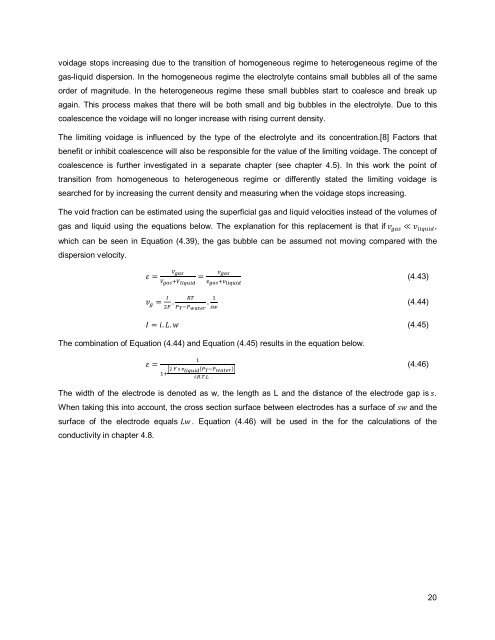A bubble curtain model applied in chlorate electrolysis
A bubble curtain model applied in chlorate electrolysis
A bubble curtain model applied in chlorate electrolysis
You also want an ePaper? Increase the reach of your titles
YUMPU automatically turns print PDFs into web optimized ePapers that Google loves.
voidage stops <strong>in</strong>creas<strong>in</strong>g due to the transition of homogeneous regime to heterogeneous regime of the<br />
gas-liquid dispersion. In the homogeneous regime the electrolyte conta<strong>in</strong>s small <strong>bubble</strong>s all of the same<br />
order of magnitude. In the heterogeneous regime these small <strong>bubble</strong>s start to coalesce and break up<br />
aga<strong>in</strong>. This process makes that there will be both small and big <strong>bubble</strong>s <strong>in</strong> the electrolyte. Due to this<br />
coalescence the voidage will no longer <strong>in</strong>crease with ris<strong>in</strong>g current density.<br />
The limit<strong>in</strong>g voidage is <strong>in</strong>fluenced by the type of the electrolyte and its concentration.[8] Factors that<br />
benefit or <strong>in</strong>hibit coalescence will also be responsible for the value of the limit<strong>in</strong>g voidage. The concept of<br />
coalescence is further <strong>in</strong>vestigated <strong>in</strong> a separate chapter (see chapter 4.5). In this work the po<strong>in</strong>t of<br />
transition from homogeneous to heterogeneous regime or differently stated the limit<strong>in</strong>g voidage is<br />
searched for by <strong>in</strong>creas<strong>in</strong>g the current density and measur<strong>in</strong>g when the voidage stops <strong>in</strong>creas<strong>in</strong>g.<br />
The void fraction can be estimated us<strong>in</strong>g the superficial gas and liquid velocities <strong>in</strong>stead of the volumes of<br />
gas and liquid us<strong>in</strong>g the equations below. The explanation for this replacement is that if v gas ≪ v liquid ,<br />
which can be seen <strong>in</strong> Equation (4.39), the gas <strong>bubble</strong> can be assumed not mov<strong>in</strong>g compared with the<br />
dispersion velocity.<br />
ε =<br />
V gas<br />
v gas<br />
=<br />
(4.43)<br />
V gas +V liquid v gas +v liquid<br />
v g = I<br />
.<br />
RT 1<br />
.<br />
2F P T −P water sw<br />
(4.44)<br />
I = i. L. w (4.45)<br />
The comb<strong>in</strong>ation of Equation (4.44) and Equation (4.45) results <strong>in</strong> the equation below.<br />
ε =<br />
1<br />
1+ 2 F s v liquid P T −P water <br />
i.R.T.L<br />
(4.46)<br />
The width of the electrode is denoted as w, the length as L and the distance of the electrode gap is s.<br />
When tak<strong>in</strong>g this <strong>in</strong>to account, the cross section surface between electrodes has a surface of sw and the<br />
surface of the electrode equals Lw . Equation (4.46) will be used <strong>in</strong> the for the calculations of the<br />
conductivity <strong>in</strong> chapter 4.8.<br />
20















